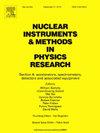Design of a multi-layered shield for low-background HPGe spectrometry
IF 1.5
3区 物理与天体物理
Q3 INSTRUMENTS & INSTRUMENTATION
Nuclear Instruments & Methods in Physics Research Section A-accelerators Spectrometers Detectors and Associated Equipment
Pub Date : 2025-01-30
DOI:10.1016/j.nima.2025.170259
引用次数: 0
Abstract
High-purity germanium (HPGe) spectrometers are indispensable tools for detecting and analyzing samples with low radioactivity levels, particularly for material screening in rare event experiments. Traditional HPGe detector shielding typically requires at least a 10 cm layer of lead or additional graded-Z liners to attenuate external radiation. However, the cost and toxicity associated with low-background lead motivate the exploration of alternative primary shielding materials. This study proposes a multi-layered, steel-based shield to address these challenges. Through Monte Carlo simulations and calculations, we determined that the optimal structure consists of a 15 cm thick steel outer layer, a 5 mm low-background lead liner, and a 1 cm inner steel liner. Experimental results demonstrated that the introduction of the 5 mm lead and 1 cm steel liner combination significantly reduced the background counting rate of the BE5030 HPGe detector below 600 keV by 40% compared to a steel-only shield. Additionally, the implementation of a boil-off nitrogen purging device effectively reduced peaks associated with radon progeny, resulting in a background counting rate of 1.5 cps for the BE5030 HPGe detector in the energy range below 3000 keV. The proposed multi-layer shield for low-background HPGe spectrometry substantially decreases the use of low-background lead while maintaining background levels consistent with those of a 10 cm low-background lead chamber through the optimization of the liner, which serves as the low-energy radiation absorber.
求助全文
约1分钟内获得全文
求助全文
来源期刊
CiteScore
3.20
自引率
21.40%
发文量
787
审稿时长
1 months
期刊介绍:
Section A of Nuclear Instruments and Methods in Physics Research publishes papers on design, manufacturing and performance of scientific instruments with an emphasis on large scale facilities. This includes the development of particle accelerators, ion sources, beam transport systems and target arrangements as well as the use of secondary phenomena such as synchrotron radiation and free electron lasers. It also includes all types of instrumentation for the detection and spectrometry of radiations from high energy processes and nuclear decays, as well as instrumentation for experiments at nuclear reactors. Specialized electronics for nuclear and other types of spectrometry as well as computerization of measurements and control systems in this area also find their place in the A section.
Theoretical as well as experimental papers are accepted.

 求助内容:
求助内容: 应助结果提醒方式:
应助结果提醒方式:


